| 8.26. Iškomponuoti | ||
|---|---|---|

|
8. Meniu „Spalvos“ |  |
Pav. 16.181. Iškomponavimas į paveikslėlius (RGB)
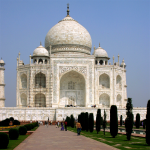
Originalus paveikslėlis

Pritaikytas filtras „Iškomponuoti“ (RGB iškomponavimas) su nepažymėta parinktimi Iškomponuoti į sluoksnius.
Pav. 16.182. Decomposition to layers (RGB)

Originalus paveikslėlis
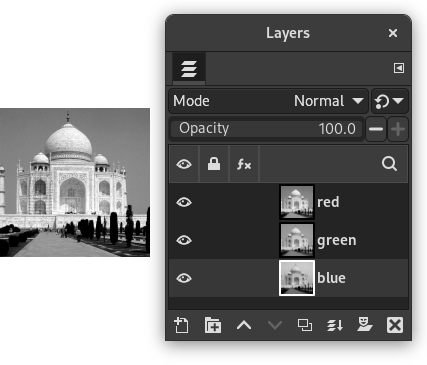
Pritaikytas filtras „Iškomponuoti“ (RGB iškomponavimas) su pažymėta parinktimi Iškomponuoti į sluoksnius.
This command separates the channels (RGB, HSV, CMYK, etc.) of an image into separated images or layers.
![[Pastaba]](images/note.png)
|
Pastaba |
|---|---|
|
This command only works on RGB images. If the image is Grayscale or Indexed, the menu entry is disabled. |
Išskirti kanalus
Šios parinktys yra aprašytos pažymėjus parinktį Iškomponuoti į sluoksnius.
If the RGB option is chosen, a gray level image is created with three layers (Red, Green and Blue), and two channels (Gray and Alpha).
This function is interesting when using the Threshold tool. You can also perform operations like cutting, pasting or moving selections in a single RGB channel. You can use an extracted grayscale layer as a selection or mask by saving it in a channel (select the whole or a part of the layer, then → ).
If the RGBA option is chosen, an image is created similar to the RGB Decomposing with an additional Alpha layer filled with the transparency values of the source image. Fully transparent pixels are black and fully opaque pixels are white.
This option extracts the image transparency stored in the Alpha channel in the Channels Dialog in a separate image. The fully transparent pixels are Black the fully opaque pixels are white. The graytones are smooth transitions of the transparency in the source image.
This option decomposes image into three grayscale layers, one for Hue, one for Saturation and another for Value.
Although Hue is grayscale, it does represent hues. In the color wheel, white and black are starting and arrival points and are superimposed. They represent Red color at top of the wheel. Gray intermediate levels are corresponding to intermediate hues on the wheel: dark gray to orange, mid gray to green and light gray to magenta.
Sodrumas ir Reikšmė: balta yra didžiausias galimas sodrumas (gryna spalva) ir didžiausia galima reikšmė (labai šviesi). Juoda yra mažiausias galimas sodrumas (balta) ir mažiausia galima reikšmė (juoda).
Ši parinktis yra panaši į HSV. Vietoje Reikšmės, trečiajame sluoksnyje yra paveikslėlio komponentas L.
This option decomposes an image into four grayscale layers, one for Yellow, one for Magenta, one for Cyan, and one for Black.
This option can be useful to transfer an image into printing software with CMYK capabilities.
This option decomposes image into three grayscale layers, layer „L“ for Luminance, layer „A“ for colors between green and red, layer „B“ for colors between blue and yellow.
LAB iškomponavimas – tai šviesingumo-spalvų giminei priskiriamas spalvų modelis. Vienas kanalas naudojamas šviesingumui, o kiti du kanalai naudojami spalvoms. LAB spalvų modelį naudoja programa Photoshop.
This option decomposes image into three grayscale layers, layer „L“ for Luminance, layer „C“ for Chroma, and layer „H“ for Hue.
The LCH Decomposing is a color model of the Luminance-Color family.
In GIMP there are four YCbCr decompositions with different values. Each option decomposes an image in three grayscale layers, a layer for Luminance and the other two layers for blueness and redness.
The YCbCr color model, also called YUV, is now used for digital video (initially for PAL analog video). It's based on the idea that the human eye is most sensitive to luminosity, next to colors. The YCbCr Decomposing uses a transformation matrix and the different options are different values recommended by ITU (International Telecommunication Union) applied to the matrix.
If this option is checked, a new grayscale image is created, with each layer representing one of the channels of the selected mode. If this option is unchecked, every channel is represented in its own image and clearly named in the name bar.
Pavyzdys 16.1. Crop marks
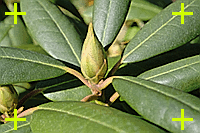
Source image
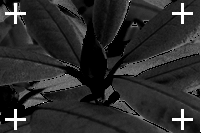
Cyan component
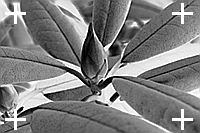
Black component
(Magenta and Yellow components omitted.)
Ši parinktis skirta specialistams. Ji susijusi su CMYK spausdinimu. Kai pažymėta, kiekvienas dabartinės priekinio plano spalvos pikselis bus juodas visuose iškomponuotų paveikslėlių / sluoksnių komponentuose. Taip jūsų sukurtos kirpimo žymės gali būti matomos visuose kanaluose, suteikiant naudingą informaciją lygiavimui. Registracijos juoda spalva išspausdintas plonas kryželis gali būti naudojamas norint patikrinti ar spausdinimo formos tinkamai sulygiuotos.